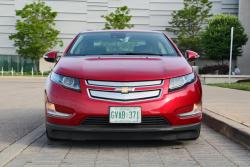 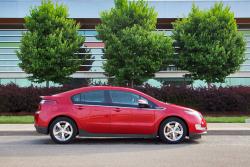 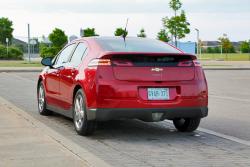 2014 Chevrolet Volt. Click image to enlarge |
Review and photos by Jonathan Yarkony
For my week with the Volt, I set myself a zero-litre challenge: commute from home to work and back every day without using a single drop of gas.
Before I get into the results of my experiment, let me remind you all about the Volt. It arrived on the scene a couple years ago hailed as a hero for GM and the next step in sustainable transportation. It hasn’t exactly flown off the shelves, so to speak. That being said, it just had its best month ever in Canada in April, but even the big incentives in BC, Ontario and Quebec haven’t helped it achieve consistent sales, and the incentives are now done in BC and set to expire in Ontario in 2015 while slowly being reduced in Quebec.
Officially able to travel up to 80 km on pure electric power, it also carries a small 1.4L gas engine to keep the battery charged (60 is more realistic under most conditions, and winter will bring it down as low as 40 km), and it can get you 500 kilometres of additional range (or more) should the need arise. The electric drive is a 111-kW motor estimated at 149 ‘motoring’ power and 273 lb-ft of torque, so it’s a bit like a diesel engine the way it pulls. The 1.4L range extender makes 83 hp, though it mostly just charges the 16.5-kWh lithium-ion battery, and drinks premium gas. I’ll get into the fuel consumption later.
As a car, the Volt is sized like a compact, reflecting its Cruze origins, but with some compromises owing to its efficient aerodynamic shape. Car & Driver recently compared some top efficiency models for aerodynamic supremacy and both the Tesla Model S and Toyota Prius beat it out, but the Volt still measured an impressive independently tested 0.28 Cd.
But back to the resulting interior: With less wheelbase but greater length than the Prius PHV plug-in hybrid, the Volt is still down on legroom and headroom in both rows, but the second row in the Chevy is limited to two low, deep bucket seats, so they are reasonably comfortable once you tuck your head under the roof and get down there, assuming the driver or passenger you’re sitting behind isn’t too tall. Okay, it’s cramped back there, but car seats install easily and securely, and it’s just the low roof that make installing the kids a bit of a chore.
Cargo space is also at a disadvantage, measuring only 300 L compared to the Prius’s 612, and it is a bit shallow and not very deep lengthwise with batteries taking up under floor space the length of the car. Packing a stroller and other various odds and ends actually challenged my packing skills. I can live with the high liftover, but more disappointing is the lack of a cargo cover, though that would have cut into packing space even more.
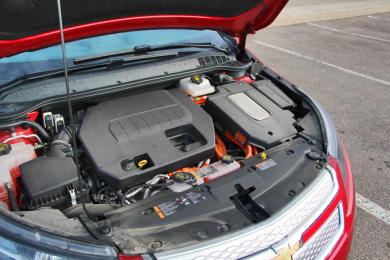 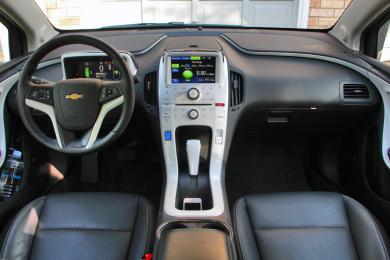 2014 Chevrolet Volt engine bay & dashboard. Click image to enlarge |
However, the Volt seats fold reasonably flat for large packages, but no official measurements are offered for maximum cargo space in the volt, though I would eyeball it at about 800 or so with seats folded down. Neat feature: the second-row armrest is removable when folding the rear seats for an almost flat load floor.
The driver’s quarters are the best of the lot – this is clearly a car designed for commuting, less so as a family vehicle. The bucket seats are spacious but supportive, and manually adjustable six ways, and I found them comfortable throughout the week. The steering wheel is also well designed in shape, but I’m not a fan of GM’s steering wheel controls; the volume is fine, but having a switch for Source and not tuning seems an odd choice, though the other controls are reasonable with cruise control and driver aids on the left-hand spoke.
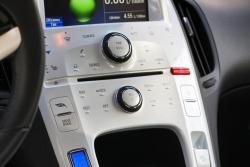 2014 Chevrolet Volt HVAC & media controls. Click image to enlarge |
Behind the wheel is a big rectangular gauge screen playing one of the coolest start-up soundtracks in the business short of a naturally aspirated V8. It is pure sci fi, with slick graphics and a very nice screen full of driving and vehicle info, though it is not quite as helpful or comprehensive as Ford’s gauges, especially for tracking hybrid performance and fuel consumption. Even the Prius PHV, with its low-tech dot-matrix screens could track trip kWh usage over several charges (until reset), which reset in the volt with every full charge.
There’s another screen in the centre stack, this one touch operated and by the array of button and touchpoints on the refrigerator door. I love the refrigerator door look, for the record, and the added touches of contrasting white plastic against the quality soft-touch plastics on the dash and doors. Unfortunately, the finish is a bit lacking, and I found some rough edges around the cabin and occasionally poor fitment and alignment.














